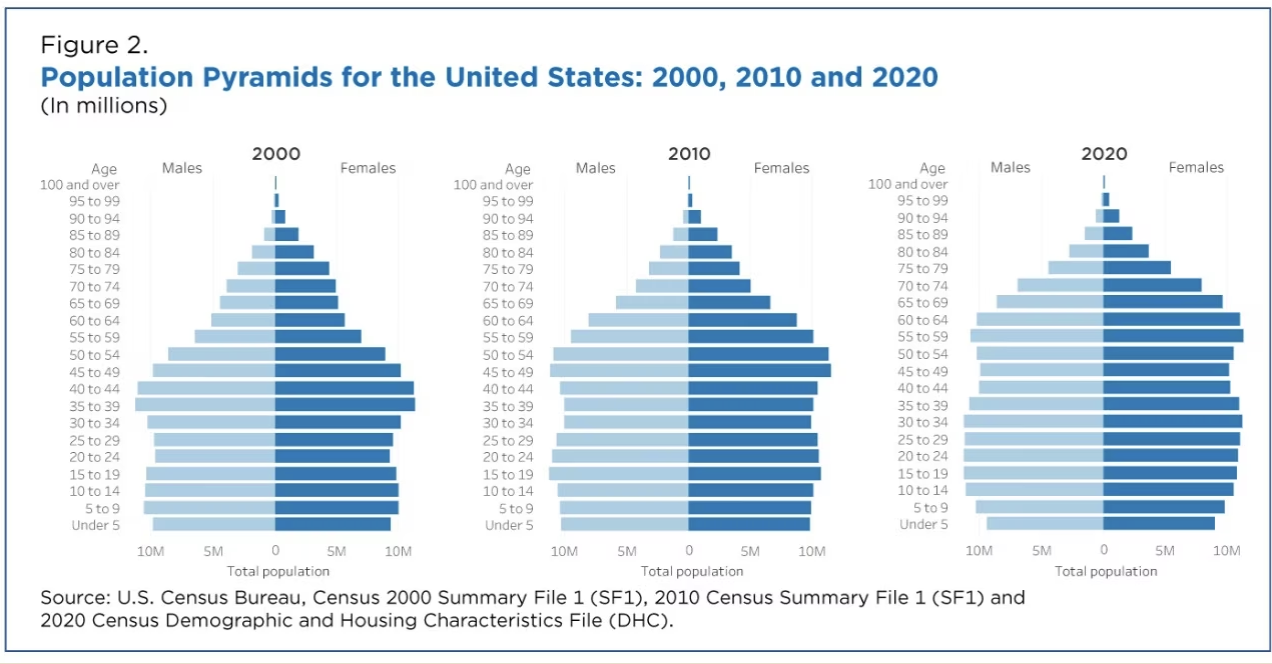Comments
- No comments found

A “population pyramid” is a graph that shows the number of people of each age group divided into male and female.
Since the oldest age groups at the top of the figure have small populations, the graph will narrow toward a point at the top. But looking across population pyramids for different years, you can see the movements of larger and smaller generations as they age. Here’s are population pyramids for 2000, 2010, and 2020 from the US Census Bureau (“Age Profiles of Smaller Geographies Don’t Always Mirror the National Trend,” by Laura Blakeslee, Megan Rabe, Zoe Caplan and Andrew Roberts, May 25, 2023).

The authors write:
The pyramid was larger in 2020 than it was in either 2010 or 2000. This reflects the growth in the U.S. population: 331.4 million people in 2020, up 22.7 million (7.4%) from the 308.7 million in 2010. Between 2000 and 2010, the population grew by 27.3 million (9.7%) from 281.4 million people. The U.S. population also aged since 2000. The baby boom cohort moved up the pyramid, from 36-to-54-year-olds in 2000 to 46-to-64-year-olds in 2010 and 56-to-74-year-olds in 2020. The millennials were mostly in their teens and 20s in 2010 but young adults (in their 20s and 30s) a decade later. At the same time, the base of the pyramid representing children under age 5 got smaller in 2020, reflecting a recent decrease in the number of births in the United States.
Population pyramid diagrams have been around a long time. The authors also include one from a Bureau of the Census report in 1900. Again, each bar represents five years of age. You can see that the number of people in the 85-90 age group almost disappears in this diagram, and the bars for those 90 and over do disappear. You can also see that this is a true “pyramid,” in the sense the younger the age group, the bigger it is. Of course, this is the sign of a growing population.

Timothy Taylor is an American economist. He is managing editor of the Journal of Economic Perspectives, a quarterly academic journal produced at Macalester College and published by the American Economic Association. Taylor received his Bachelor of Arts degree from Haverford College and a master's degree in economics from Stanford University. At Stanford, he was winner of the award for excellent teaching in a large class (more than 30 students) given by the Associated Students of Stanford University. At Minnesota, he was named a Distinguished Lecturer by the Department of Economics and voted Teacher of the Year by the master's degree students at the Hubert H. Humphrey Institute of Public Affairs. Taylor has been a guest speaker for groups of teachers of high school economics, visiting diplomats from eastern Europe, talk-radio shows, and community groups. From 1989 to 1997, Professor Taylor wrote an economics opinion column for the San Jose Mercury-News. He has published multiple lectures on economics through The Teaching Company. With Rudolph Penner and Isabel Sawhill, he is co-author of Updating America's Social Contract (2000), whose first chapter provided an early radical centrist perspective, "An Agenda for the Radical Middle". Taylor is also the author of The Instant Economist: Everything You Need to Know About How the Economy Works, published by the Penguin Group in 2012. The fourth edition of Taylor's Principles of Economics textbook was published by Textbook Media in 2017.
Leave your comments
Post comment as a guest